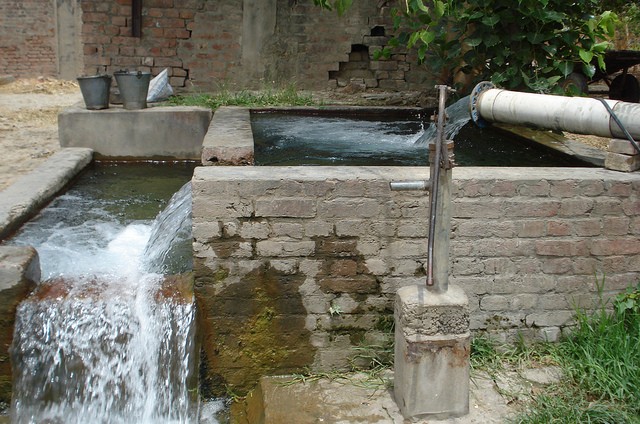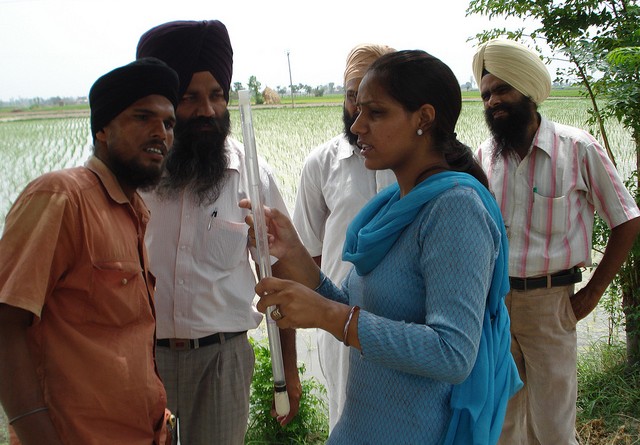Punjab, the "breadbasket" of India, was historically considered to be one of the most fertile areas on Earth, producing wheat, cotton, sugarcane and vegetables. In the 1970s, however, the Indian government's "Green Revolution" sought to combat famine and poverty in the region by increasing yields in Punjab. New policies and agricultural techniques were undertaken to accomplish these goals, but over time they began to have unintended ecological and social consequences.

Since then, wheat and rice production has grown increasingly important, as Punjab became a government mandated rice district primary source for government grain reserves. Covering only 1.5 percent of India’s land, today the state produces nearly 20 percent of the nation’s wheat and 12 percent of its rice.
The ubiquitous practice of annual rice/wheat cropping comes with a huge cost, however, consuming enormous resources, from fertilizers to maintain high yields to enormous amounts of electricity to pump declining groundwater from ever-greater depths. Rice in particular is a very water intensive crop requires seasonal flood irrigation of fields. As farmers drill deeper and deeper they tap older and older aquifers that will take many years to recharge.
This trend of excessive groundwater drafting for agriculture has led to water tables dropping at an alarming rate; 79 percent of the groundwater assessment divisions (“blocks”) in the State are now considered ‘overexploited’ and ‘critical’ with extraction exceeding the supply. From 1982-87, the water table in Central Punjab was falling an average of 18 cm per year. That rate of decline accelerated to 42 cm per year from 1997-2002, and to a staggering 75 cm during 2002-06. Water tables are now falling over about 90 percent of the state, with Central Punjab most severely affected.
As part of the Green Revolution push for higher yields and more production of staple crops, both state and federal governments in India have for years heavily subsidized electricity to farmers for irrigation pumping. As a result, electricity consumption by farmers has also increased steadily over the years, as more and more energy is required to pump water from ever-deeper depths.
The potential effects of groundwater depletion include the drying up of wells, reduced stream flows, deteriorating water quality and sinking land as well as increased costs and lower profit margins for farmers. In Punjab, smaller farmers are the first to suffer; as production costs rise, many are forced to take on debts they cannot hope to repay. As a result, the once prosperous farmers of Punjab increasingly struggle.
The Columbia Water Center Project
The Columbia Water Center is collaborating with Punjab Agricultural University on field research in Central Punjab to study, test and implement practical, rapidly scalable solutions to Punjab’s groundwater depletion crisis. In the first phase, through a structured field test the research team attempted to identify one or more technologies or practices that save water in rice cultivation. In the second phase, the project team developed and is pursuing a strategy to rapidly recruit farmers to scale up the application of the tensiometer, the most successful of the approaches tested in the first phase.
In addition, the team is working with corporate food producers such as Del Monte/FieldFresh to study the potential to promote more diverse and water-efficient cropping patterns among farmers through contract farming. Such contracts are designed to grow farmer income without increasing crop risk, while providing corporate partners with higher value crops such as vegetables and corn.
Tensiometers: More Crop Per Drop
Of the approaches tested in the first phase of the project, the tensiometer, a tool used to measure the moisture content of the soil, quickly emerged as the most successful an easily adopted approach to save water in rice cropping.
Tensiometer technology dates from the early years of the 20th century. The device typically consists of a sealed, water-filled tube with a ceramic porous cup and a vacuum gauge at the top; the device is designed to provide an estimate of soil moisture. As soil moisture decreases, the water level in the tube goes down. If the indicated soil moisture is lower than the desired level for a crop, the farmer needs to water. By taking the guesswork out of irrigation, the device allows farmers to water only when needed, thus saving water and promoting better crop health. Costing between $40 and $200 however, conventional tensiometers are out of reach for most farmers in the developing world.
To address this problem, several years ago Dr. Kukal a PAU scientist, developed a simpler, more affordable tensiometer that cost only $7. In part this was accomplished by replacing complex gauges with three bands—red, yellow and green—to indicate when a crop should be irrigated. By calibrating the tensiometer for a specific crop (in this case rice) they were able to produce a device that was not only substantially less expensive than the conventional alternatives but also easy for farmers to use.
For the pilot project, the PAU/CWC team recruited 525 rice farmers and provided them with tensiometers for the first large-scale field test of the technology. Eighty five percent of the farmers who were initially recruited in 2010 followed through with the entire experiment. Of these, all reported consistently good results and indicated their intention to convert their full operation to tensiometer use in the next cycle.

Farmers who completed the trial reported an average of 22 percent water savings over conventional methods, and 24 percent energy savings. The farmers reported no decline in yield from using less irrigation. These results suggest that a rapid scale-up of this technology could save a truly significant amount of water and energy in Punjab, and thus play a critical role in stemming or reversing Northwest India’s groundwater depletion crisis.
If widely applied, the tensiometer technology could save enormous amounts of energy and improve the stability of the electrical grid as well, as farmer irrigation accounts for a significant percentage of Punjabs electricity consumption. In fact, the tremendous amount saved on energy costs alone could more than pay for the technology. If farmers adopted tensiometers for 60 percent of the area under rice cultivation, for example, the total savings per season would be approximately $36 million, compared to a one-time cost of $28 million for tensiometers.
In 2011 the CWC/PAU recruited an additional 4,500 farmers to participate in the next phase of the tensiometer trial. We believe that the demonstrated effectiveness of this simple, affordable technology will facilitate even more rapid adoption in the next few years and look forward to working with our partners to continue to promote its dissemination.
Learn More
Results of Punjab farmer surveys: Part One, Part Two
Articles from State of the Planet:
Direct Seeding of Rice A Simple Solution to Indias Water Crisis?
Punjab Farmers Adapt to Shrinking Water Supply
Punjab: Less Water, More Money: Part 1, Part 2, Part 3
Videos on Solving Punjab’s Water Crisis:
Interview with Dr. SS Johl about water policy in Punjab, India
Dr. Rajinder Sidhu and Dr. Kamal Vatta discuss:
